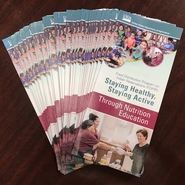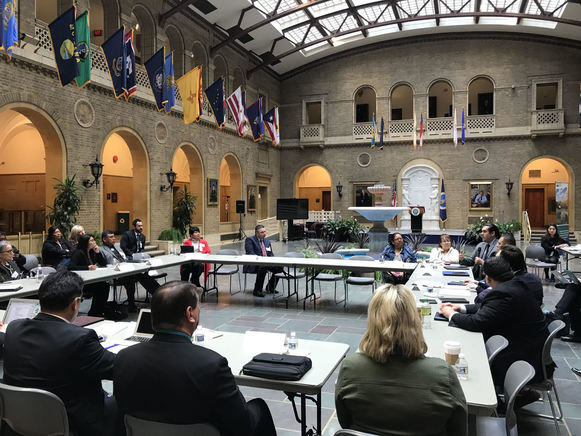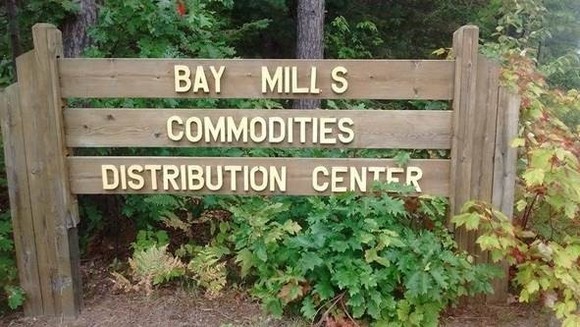|
FDPNE Grant Application Now Open
The Food and Nutrition Service (FNS) is pleased to announce that the Request for Applications
(RFA) for the Fiscal
Year (FY) 2018 Food Distribution Program on Indian Reservations Nutrition
Education (FDPNE) grant has now been posted to Grants.gov. The FDPNE grant
funds projects that provide nutrition information and services to Food Distribution Program on Indian Reservations (FDPIR)
participants, helping the organizations that serve this population find new
ways to aid their constituents. Indian Tribal Organizations and State
agencies that are current FDPIR allowance holders (have a direct
agreement with FNS to administer FDPIR) are eligible to apply. You can read
about projects funded last year here.
For FY 2018, FNS has revised and updated the RFA and
application, so all applicants are encouraged to read the document closely for
any information that might have changed from previous years. To see the RFA
itself, you can view the grant opportunity web page by following this
link. On that page, you can also find supplemental documents, such as a
sample budget narrative, sample project timeline, and match calculator to help
you apply.
Interested in learning more? FNS hosted a webinar on
February 27. If you were unable to attend, you can view the
recording here.
New FDPIR Infographics and Nutrition Education Brochure
 USDA is delighted to share new materials for FDPIR! A new brochure, "Staying Healthy, Staying Active Through Nutrition Education" (pictured to the right), showcases the variety of hands-on, instructional, and physical activities offered at FDPIR local sites and provides ideas for additional partnering and funding opportunities. Copies of the brochure were mailed to all FDPIR Indian Tribal Organizations in December 2017, and the brochure is now also available electronically in the FDPIR Sharing Gallery's Digital Resources section.
A set of three new infographics tells the story of FDPIR by highlighting key data points related to household composition (pictured below), healthy foods, and nutrition education. If you've ever wondered how many FDPIR households include children or elderly members, how the FDPIR food
package compares to the average American diet, or how nutrition education is
changing the ways program participants cook and eat, visit the Sharing Gallery to learn all this and more!
|
 |
As of March 1, programs administering FDPIR are able to order bakery mix in a 20 oz. bag. This change provides a
smaller pack size product and changes the distribution frequency of bakery mix
to one 20 oz. bag per person per month. Also starting March 1, programs administering FDPIR are able to order applesauce in a 6-cup sleeve
with the canned product being phased out. The cups are 4
oz. each. A revised FDPIR Monthly Distribution Guide Rates by Household Size document
with an effective date of March 1, 2018, reflecting these changes has been released and posted to the FDPIR
website.
The new 20 oz. bakery mix (left) and the new 6-cup sleeve of applesauce (right) are now available for FDPIR programs to order.
Applesauce is now
available in a convenient new form! As noted in the Policy Corner article above, FDPIR
programs are now able to order applesauce in a new package with six
4-oz. cups of applesauce to replace the canned item. The product inside
is the same as the can, but the packaging now offers convenient, individually
portioned servings great for breakfast, lunch, or snacks. Unsweetened
applesauce can be served as a healthy dessert, sprinkled with cinnamon, or used
as a topping for pork chops, pancakes, or oatmeal.
The FDPIR Foods
Available List is Getting a Makeover!
Each year, USDA publishes a list of the foods expected
to be available through USDA Foods. This year, the list is taking on a new, colorful look that will also provide
programs with information about how each food offered can help participants to
meet the dietary recommendations based on MyPlate. USDA recently launched the new version of the
Foods
Available List for FDPIR that highlights the variety of nutritious foods
available through the program and how these foods contribute to a healthy
diet. For example, the whole grain labels
can help programs to offer a variety of grains and encourage participants to
select both whole grain and enriched grain options. If you have questions or feedback about the
new look or the information provided, please contact us at USDAFoods@fns.usda.gov.
Refining Our Grain Approach – The Year Ahead
During the annual FDPIR Food Package Review
Strategic Planning Meeting held November 29-30, 2017, Work Group members
participated in a presentation by Desiree Jackson, a nutritionist representing
the Western Region. Ms. Jackson provided a “through the years” look at
improvements made in the FDPIR food package, from adding frozen beef 30 years
ago to decreasing sodium and sugar, adding more whole grain options,
introducing fresh produce, and, recently, providing a selection of traditional
foods. Of importance, the presentation noted how the FDPIR food package
scored a 73 out of 100 under the Healthy Eating Index (HEI), a tool designed to
assess diet quality in terms of how well diets comply with the Dietary
Guidelines for Americans. Additionally, the HEI captures balance among food
groups and can also be used to assess the quality of any group of foods. Ms. Jackson’s presentation noted the high scores received in FDPIR food groups
and an area of improvement in refined grains.
Work Group members agreed to
work together this year and review opportunities for potentially making modest
adjustments to grain categories while increasing vegetable guide rates. During the November meeting, Work Group members also discussed other priority
food items such as traditional foods, including adding catfish, and
taste-tested frozen options for blueberries, carrots, and peas, all received
with favorable results. Work Group members are excited for the year ahead
and continuing the discussion throughout the year, including at our next
face-to-face meeting at the 2018 National Association of Food Distribution
Programs on Indian Reservations (NAFDPIR) annual conference, in Reno, Nevada, in June.
Attendees of the annual FDPIR Food Package Review Strategic Planning Meeting in Alexandria, Virginia, in November 2017
Government-to-Government Discussions Continue at USDA
On February 15, 2018, Tribal leaders and representatives
from more than ten Nations came together for a formal consultation between Tribal
Governments and USDA. The consultation meeting, organized under the National Association of Food Distribution Programs on Indian Reservations (NAFDPIR) as the Tribal Leaders Working Group, centered around FDPIR. Food and Nutrition Service (FNS) Administrator and Food, Nutrition, and Consumer Services (FNCS)
Acting Deputy Under Secretary Brandon Lipps participated in the meeting as the
consulting official and dialogued government-to-government on important issues
facing the FDPIR community. Main topics covered included traditional foods, nutrition education, upgrades to technology
systems, and general discussion on USDA vendors, funding, and the Farm Bill. Tribal leaders expressed interest in continuing to dialogue and extended an
invitation to look at additional dates to meet again.
 Tribal Leaders Consultation on USDA's Whitten Patio in Washington, DC, in February 2018
Update: FDPIR Nutrition Paraprofessional Training Assessment
Project
The Office of Management and
Budget recently provided approval to collect data for the FDPIR Nutrition
Paraprofessional Training Assessment Project. The project will help USDA learn
more about the nutrition education training needs of FDPIR local agency
staff. In general, nutrition paraprofessionals are persons who do not
have formal nutrition education, training, or licensure obtained from a college
or university. For FDPIR, USDA is considering the development of a
project that offers culturally relevant
nutrition training, conducted by a Registered Dietitian, that prepares a staff
person to provide basic nutrition information to participants.
USDA has
moved forward with our research partners, 2M
Research Services, LLC and Mathematica Policy Research, to
complete the tasks needed to schedule and conduct telephone interviews with
FDPIR local agency staff and other stakeholders. The information obtained
will contribute valuable input regarding the need for such a project, the
topics staff would like to learn about, and how the training should be
delivered.
Interviews are taking place
currently and are expected to be completed by mid-March 2018. We encourage
FDPIR local agency staff to respond if you received an e-mail invitation to
participate from 2M Research Services, LLC.
Bay Mills Plans Community-Based
Nutrition Education
The Bay Mills FDPIR program in Michigan will embark on a
community-based nutrition plan this year in partnership with the Bay Mills Wiisinida
M’no community coalition. Administrative
nutrition education funding will be used to conduct a wide variety of
activities to support food sovereignty and nutrition education. The project
will begin with a Michigan State University Master Canner teaching a series of
food preservation workshops focusing on traditional foods, such as fish and
venison. Participants will also receive a food preservation guide book. The coalition will also host a workshop where
raised beds will be built on the Waishkey Bay Farm college farm and at the FDPIR
warehouse site to teach and engage FDPIR members in growing herbs and
vegetables. The partnership with the farm will provide additional space for raised
bed activities, along with the expertise of the farm staff. Lastly, three six-week
Cooking Matters courses will be offered throughout the year to teach clients
how to prepare food in a healthy manner and to make nutritious choices.
Participants will also receive a cookbook.
These activities will be promoted to
FDPIR clients by providing information at the FDPIR warehouse, sharing information through social media
platforms, and utilizing the Bay Mills email directory. Partners of the Bay
Mills Wiisinida M’no community coalition include the Bay Mills Community
College’s Waishkey Bay Farm, Bay Mills Health Center’s Bemidji Area Leaders Acting
for Change (BALAC) and Racial and Ethnic Approaches to Community Health
(REACH), Michigan State University Extension’s Federally Recognized Tribes
Extension Program (FRTEP), and Bay Mills FDPIR program.

Lummi Nation FDPIR Completes FY 2016 Infrastructure Award Project
 Lummi Nation FDPIR in Washington took full
advantage of an FY 2016 Infrastructure Award that USDA made
available to FDPIR grantees. Lummi paved its parking lot to provide better access for participants coming to pick up food, replaced
an aging forklift, purchased a new vehicle to expand home delivery services,
and remodeled its well-used kitchen!
Lummi FDPIR is pleased to announce that the kitchen remodel project is complete and in full operation. The kitchen went through a very thorough
renovation. The electrical system was upgraded to prevent blowing circuits and
to ensure the kitchen was safe. The dishwasher, stove, and the hood were
replaced with commercial grade appliances. An ice maker was installed to help maintain ice baths when conducting cooking
demos and serving food at special events.
|
 |
Staff from Lummi FDPIR and the Lummi Health Clinic have been
utilizing the kitchen weekly to demonstrate recipes for FDPIR clients and
provide nutrition education. Successful
events have included how to incorporate more fresh produce into recipes and safely
can sockeye salmon and delicious fruit jams. The classes have been very popular, especially with young families who
are excited to learn how to preserve food for the winter months.
Elaine Lane, Lummi Commodity Program Director, shared that the Lummi
Health Clinic assisted with funding for the kitchen remodel because they
have clients in common and by working together…"We can make a difference!" Congratulations to Elaine and all the
Lummi FDPIR staff!
Lummi FDPIR staff and clients canned sockeye salmon; pictured above is the result of one day's work!
Julianne Jones, Lummi FDPNE Coordinator, demonstrates how to make Pico de Gallo Dip (left) and Monica Sullier, Lummi Clinical Dietitian, conducts a cooking demonstration (right).
In the USDA DoD Fresh
Fruit and Vegetable Program, vendors are required to offer U.S. grown, U.S. No. 1 or better fresh
fruits and vegetables. This requirement is verified through Defense Logistics
Agency (DLA) Produce Quality Audits. Fresh fruits and vegetables are inspected
to ensure customers are receiving safe produce of an optimum quality
level. Weekly, vendors upload a catalog
of allowable FDPIR produce items so Indian Tribal Organizations (ITOs) are able
to order fresh in-season produce as part of their monthly food package benefit.
It is the ITO’s responsibility to inspect each delivery as it is being unloaded
to ensure the overall quality and condition of the items. At the time of
delivery, staff must examine the quality of the produce to check for condition defects.
Condition defects are bruising, sunken discolored areas, shriveling, surface
discoloration, and decay. These defects will worsen over time. Cartons should
be opened to check produce quality and condition. Each layer of product on the
pallet should be randomly checked, not just the top layer cartons. When inspecting
a case of produce, no more than 10% of the case may fail to meet the
requirements, including not more than 2% that are affected by mold or decay. For example, if you have a case of 100 apples, 10 apples are allowed to have defects. However, only 2 apples are allowed to have mold or decay. It is important to train staff on
how to properly accept and inspect produce. Take time to walk around pallets,
open cases, and, if needed, open internal packaging to examine produce. After a
thorough inspection, staff should reject poor quality product.
ITOs should note all
issues such as shortages/overages, condition of delivery upon arrival, the wrong
products delivered, and detailed product quality issues prior to acceptance on
the signed delivery receipt. Please make copies of this documentation for your
records. Pictures of the cases and product are very helpful to DLA and the
vendor. Notify the DLA representative within one business day of delivery of
any quality or condition defects discovered after acceptance of the order. DLA representatives
provide direct customer service to customers. They are the direct contact
between DLA contracting and the vendor. All vendor performance issues are
handled by DLA contracting officers to ensure the vendors are fulfilling the
terms of their contract. Product complaints are sent to DLA contracting for
vendor performance files and follow-up action, as needed. This feedback is
important when contracts are being re-solicited.
USDA DoD
Fresh Complaint Process: ITOs are to
report issues with produce received through the USDA DoD Fresh Program concerning
produce quality, condition, and delivery to the appropriate DLA Service Representative, the vendor, and the appropriate FNS Regional Office
staff.
If issues are
reported and not resolved, please contact the USDA Complaints Team at
800-446-6991. We will work with DoD to resolve the issue. We welcome your
feedback on produce received through the USDA DoD Fresh Program.
For more information on "The Basics" of the USDA DoD Fresh Program in FDPIR, please view our webinar, available on YouTube here.
USDA Foods
Complaint Hotline Email: USDAFoodsComplaints@fns.usda.gov
The Complaint
Team is available Monday-Friday, 6:00 a.m. – 5:00 p.m. Eastern Time.
New “My Profile” Available in FFAVORS
With the January 2018 release for the Fresh
Fruits and Vegetables Order/Receipt System (FFAVORS), a new My Profile link has been added to the
main menu. This will allow all users to review and update their own contact
information to ensure they receive communications related to system updates,
orders, and any questions or requests for assistance submitted through the
FFAVORS application.
My Profile
is located at the bottom of the menu on the FFAVORS home page for both
Customers and Vendors:
Vendors can make updates to their email address.
Customers can edit their email address as well as phone
number, extension, and fax number.
Additionally, Customers can opt-in to receive email
notification for new USDA
DoD Fresh orders or modifications to existing orders to be delivered to
their organization. The first option will notify the user when they create or
modify orders in FFAVORS. The second
option will notify the user when other users from their tribe or from the
Defense Logistics Agency create or modify orders.
Please contact the FFAVORS
Help Desk with any questions.
USDA staff will be participating in these upcoming meetings in 2018. We look forward to the opportunity to meet you and hope to see you there!
March 13-14: Midwest Region FDPIR Nutrition Advisory Committee Meeting in Chicago, Illinois.
March 19-22: Western Region FDPIR Meeting and Nutrition Education Symposium in Rhonert Park, California.
June 11-15: National Association of Food Distribution Programs on Indian Reservations (NAFDPIR) Annual Conference in Reno, Nevada.
 1. Click here. Or you can go to the Food Distribution website and click on the red envelope on the row of social media icons on the top right of the page.
2. Enter your email address and click "Submit."
3.
Check the boxes to select your topic(s) of interest. For these
e-letters, scroll down to the Food Distribution category and click the
plus sign to the left of the check box to expand the list and view all
the topics. Select any of these topics to receive the general e-letter
plus the corresponding program-specific e-letter(s) of your choice:
*USDA Foods --> receive all "USDA Foods from Farm to Plate" e-letters
*Commodity Supplemental Food Program (CSFP) --> receive "Household Highlights"
*The Emergency Food Assistance Program (TEFAP) --> receive "Household Highlights"
*Food Distribution Program on Indian Reservations (FDPIR) --> receive "FDPIR Connection"
*Schools/Child Nutrition Commodity Programs --> receive "Spotlight on Schools"
4. Visit the subscriber preferences page any time you would like to review, add, or delete subscriptions. Questions? Contact USDAFoods@fns.usda.gov.
5. Share the e-letter and new subscriber link with interested colleagues and friends!
|
|